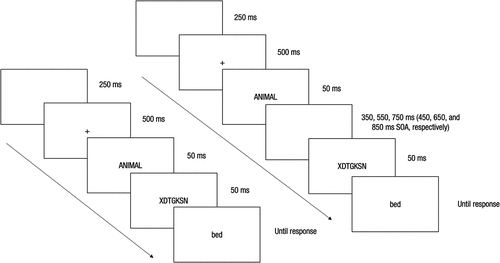Figures & data
Figure 1. Sequence of trials in the category semantic priming task with the short 100-ms SOA (left) and the long 450-, 650- and 850-ms SOAs (right).

Figure 2. Intermediate-type chronotype. Performance at the short (100 ms) and the long (450, 650, and 850 ms) SOAs. (a) Accuracy priming effects. (b) RTs priming effects at the short 100 ms SOA as a function of subblocks. (c) RTs priming effects at the long SOAs. Asterisks indicate statistically significant effects (p < 0.05).

Figure 3. Morning-type participants. Performance at the short (100 ms) and the long (450, 650, and 850 ms) SOAs during optimal and non-optimal times of day. (a) Accuracy priming effects. (b) RTs priming effects. Priming effects did not vary for the three subblocks of the 100-ms SOA; consequently, they are not shown. The letter “a” indicates marginally significant effects (p < 0.10), and asterisks indicate statistically significant effects (p < 0.05).

Figure 4. Evening-type chronotype. Performance at the short (100 ms) and the long (450, 650, and 850 ms) SOAs during optimal and non-optimal times of day. (a) Accuracy priming effects. (b) RTs priming effects. Priming effects did not vary for the three subblocks of the 100-ms SOA; consequently, they are not shown. The letter “a” indicates marginally significant effects (p < 0.10), and asterisks indicate statistically significant effects (p < 0.05).

Supplemental Material
Download MS Excel (20.5 KB)Data availability statement
The dataset generated and analyzed during the current study as well as the R scripts used to preprocess the data are available in OSF repository (peer-review link): https://osf.io/kjhna/?view_only=16bc0c55949d4fa5ad800c60e0a692ec.
